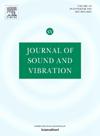Interval-oriented eigensystem realization algorithm and its modification for structural modal parameter identification with bounded uncertainties
IF 4.3
2区 工程技术
Q1 ACOUSTICS
引用次数: 0
Abstract
Structural modal parameter identification is the initial step in modeling, monitoring and controlling dynamic systems, which can determine the accuracy of dynamics and control research. However, the uncertainty of dynamic systems is difficult to quantify, which will lead to deviations in structural modal parameter identification. Aiming to identify modal parameters under the influence of structural uncertainty parameters, this study proposed a novel interval-oriented eigensystem realization algorithm (ERA) and its modification with bounded uncertainties, which is particularly suitable for the case where structural uncertainty samples are scarce. The uncertain structures are quantified as interval uncertain parameters, which can reduce the need for quantification of uncertainty parameters without loss of accuracy. The first and second-order interval-oriented singular value decomposition (SVD) is developed, which is regarded as an important tool to solve the interval Hankel matrix. The conventional modal parameter identification method of ERA and ERA/DC are extended into the interval framework using first and second-order interval perturbation with a detailed derivation process, and the identified bounds of frequency and damping ratio can be accurately estimated using both interval-oriented ERA and ERA/DC in conjunction with first and second-order interval perturbation SVD. Finally, two numerical examples and one experimental verification are used to assess the proposed method.
求助全文
约1分钟内获得全文
求助全文
来源期刊

Journal of Sound and Vibration
工程技术-工程:机械
CiteScore
9.10
自引率
10.60%
发文量
551
审稿时长
69 days
期刊介绍:
The Journal of Sound and Vibration (JSV) is an independent journal devoted to the prompt publication of original papers, both theoretical and experimental, that provide new information on any aspect of sound or vibration. There is an emphasis on fundamental work that has potential for practical application.
JSV was founded and operates on the premise that the subject of sound and vibration requires a journal that publishes papers of a high technical standard across the various subdisciplines, thus facilitating awareness of techniques and discoveries in one area that may be applicable in others.
 求助内容:
求助内容: 应助结果提醒方式:
应助结果提醒方式:


